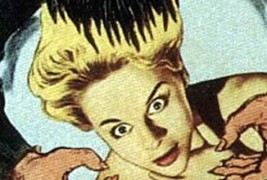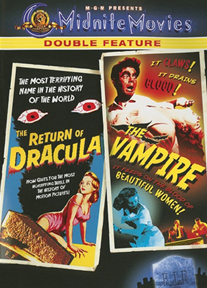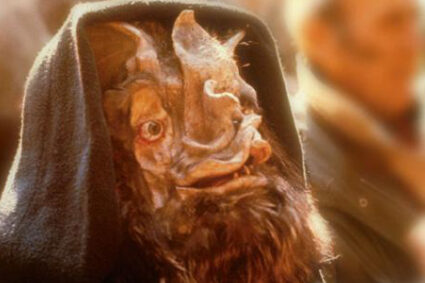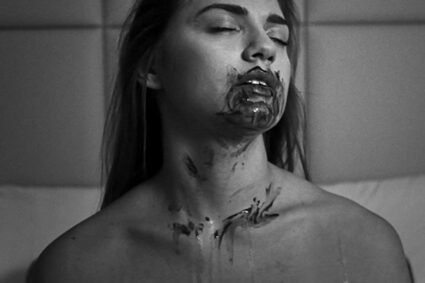
Ravenous Monster’s retrospective series continues with another diagnosis from the good Dr. Abner Mality….
Greetings, fear freaks! Today we take a strange detour through the decade of the 50’s, the years when the shadow of the mushroom cloud loomed over horror like…well, like a mushroom cloud! This was the age of the atom, when radioactive mutants ran amuck, giant insects plagued the world and slumbering dinosaurs awoke due to nuclear mishap. It was also the age of the alien, as visitors from the stars tumbled to Earth in vast numbers, with most of them being none too friendly.
Faced with this onslaught of scientific mutation, the old monsters of the 30’s and 40’s, the vampires, werewolves and mummies, retreated to their catacombs. It seemed the real horror of Hiroshima reduced the supernatural beings of old to quaint bygones. Or did they?
Classic horror is hard to kill. The end of the 50’s brought the rise of an English studio known as Hammer, that would soon return Dracula and Frankenstein to prominence with a new and bloodier take on their familiar tales. But overshadowed by Hammer’s success are a few brave horror tales from America that tried to update the classic formula in their own unique ways. Most of these films have vanished into almost total obscurity, overwhelmed by atomic monsters and Hammer’s success. That brings us to the subject of this little treatise.
During the late 50’s, there were a series of low-budget but thoughtful monster movies scripted by a clever lady named Pat Fielder. Those who saw the name on the credits of these films felt certain Pat was a guy which was probably just the way the studio wanted it. These movies were all concerned with taking some typical monster/SF cliché and updating it in a fresh way. Two of them were straight up science fiction: “The Flame Barrier”, an extremely rare movie dealing with a deadly organism brought back to Earth by satellite, and “The Monster That Challenged the World”, the story of giant prehistoric millipedes invading the Salton Sea area of California. To this day, I haven’t seen “The Flame Barrier” and it has never been released on DVD. But “The Monster That Challenged the World” is one of my favorite “big bug” movies. In fact, I put it right up there with “Them!” and “Tarantula” as the best of the breed.
Fiedler, with the help of talented director Paul Landres, also tackled the subject of vampirism in two more movies, “The Return of Dracula” and “The Vampire”. And those are the films I will put under my cinematic microscope this time around.
We’ll start with 1958’s “The Return of Dracula”, even though it was made after “The Vampire”. The film came out the same year as Hammer’s “Horror of Dracula” and the bloody, bombastic English shocker pretty much plowed the low-budget American movie right into the ground. In fact, “Return of Dracula” may be the most obscure Dracula movie ever released by a major studio (not counting cheapo porn parodies, exotic foreign films and micro-budget home movies). However, those few who have seen it have found it to be a very unique look at how the King of the Vampires adapts to life in bucolic 1950’s suburbia and the reputation of the movie has steadily grown.

The film is structured in a highly unorthodox manner and the strange pacing works to the movie’s advantage, as you are never quite sure what’s going to happen next. It is definitely a low-key film and I’ll say right now, if you’re looking for jolting shocks, gore and non-stop action, you’d better stay clear. In many ways, “The Return of Dracula” is a film noir with vampire elements and many pundits have compared it to a supernatural version of Hitchcock’s “Shadow of a Doubt”. Only in this case, Uncle Charlie is Count Dracula himself!
A grim-toned narrator tells us we are in modern Transylvania (part of Romania), where, despite propaganda to the contrary, vampires exist and Dracula is the worst of them all. We follow a determined group of men led by Inspector Merriman as they trudge through a graveyard in search of a grave. The sun is about to come up, so they know their prey will be present. But to their shock and surprise, the tomb they open is empty. Dracula has escaped and is on the loose!
We next get a very atmospheric and cool shot of Dracula materializing out of the fog at a night-time train station. And now is the time to mention the excellent performance of Francis Lederer as Dracula. The urbane and very Continental-looking Count is clearly a vampire who has kept up with the times. No cape for this fiend, but a billowing trench coat serves in much the same way. With a fedora hat and snazzy attire, this Dracula would pass for a handsome middle-aged businessman. Lederer plays Dracula in a totally different manner from Lugosi, Lee, Oldman and the other screen vampires…subtle, even friendly and polite at times, but ultimately completely evil. Lederer, who went on to become a successful financier after retiring from acting, was said to hate this movie, but honestly he had no reason to, as it is a very effective performance.
Dracula makes his way to the train compartment occupied by one Bellac Gordal – one of the lucky few who has been granted permission to leave the country to visit distant relatives in America. Only perhaps Gordal is not so lucky after all. A hypnotic gaze from the stranger sitting across from him, a quick twist of the neck and Bellac Gordal’s troubles are over for good. Things are getting a bit too hot for Dracula in the “Old Country”, so it’s time to visit America and see what the hunting is like in small-town California.
That’s our cue to jump to a small unnamed community in the California foothills. It’s the kind of place that Wally and The Beav could have easily called home. The idyllic simplicity of this community might prompt a lot of snickers from today’s jaded viewers, but it is absolutely integral to the horror of this story. Count Dracula represents all the decadence and decay of old Europe while small town suburban America of the 50’s is the complete antithesis of that. “The Return of Dracula” is therefore a culture clash of the most extreme kind. And although this sort of safe and homey community seems mostly a thing of the past today, I can assure you that it did at one time exist.
We now are introduced to the Mayberry family. Yes, that is actually their surname, but Barney Fife is unfortunately nowhere to be found. Widow Cora is the family matriarch while teenage daughter Rachel and young Mickey are the children in her care. Cora is eagerly awaiting the arrival of a long-unseen relative from “The Old Country”, a painter named Bellac Gordal.
In a neat take-off on the earlier scene Dracula materializes at the local train station in much the same manner he did back in Transylvania. He finds the Mayberrys and introduces himself as “Cousin Bellac”. The unsuspecting family is only too happy to welcome him, the arch-fiend of darkness, into their home!
There’s no need to cover the rest of the film in detail, but “Cousin Bellac” soon sets up shop in his new American home and bodies begin to appear, drained of blood. Dracula is especially taken with young Rachel (naturally) and sets about seducing her in a subtle way, with the ultimate goal of making her his vampire bride. Actress Norma Eberhardt is very effective in her role as Rachel, seeming to be an all-American girl much of the time, but with a strange dark side. Dracula’s appeal to her gives the opportunity for finely delivered dialogue like this: “You only fear the unknown. Only this casing, this clumsy flesh stands between you and me. You are already balanced between two worlds. Eternity awaits you now.”
Rachel’s high school jock boyfriend is suspicious of Cousin Bellac, who keeps odd hours, but the foreign visitor is too charming and self-assured to challenge directly. But odd events continue to take place. Rachel’s friend, the blind and sickly Jennie Blake, succumbs to a peculiar “wasting disease”. But then she’s seen prowling around in white after her demise, much like Mina Harker did in the classic Dracula tale. An insurance investigator looking into the unusual deaths is savagely attacked by a white wolf. And finally, a strange visitor from Europe, an Inspector Merriman, arrives and reveals that he believes a vampire has made its home in small town California.
The rest of the movie you’ll have to see. The ending may be considered somewhat disappointing but it is quite ironic and nicely set up by an earlier scene. The movie is in subdued black and white, which greatly works to its advantage, with the exception of one shocking scene in color – the closest thing this movie gets to an actual visceral jolt. I’ll let you discover that for yourself, too.
“The Return of Dracula” is a very different kind of vampire movie that still manages to embrace all the clichés we know. Judging by its budget, one would expect a potboiler ready for the drive-in, but the acting, script and direction is way above the norm and shows the Fiedler/Landres duo to best effect. Film noir fans would certainly enjoy this treatment and if you are a Dracula completist, you owe it to yourself to see Francis Lederer’s excellent interpretation.
A year earlier, the Fiedler/Landres combo had tried a completely different take on vampirism with “The Vampire”. It would be hard to imagine a vampire movie more different than “The Return of Dracula”, yet both films are excellent in their own ways. I remember “The Vampire” very well from my misspent childhood, which was spent sneaking out to the TV way past my bedtime and fiddling with the aerial in a desperate attempt to tune in every monster movie possible. “The Vampire” pretty near traumatized me with two brutally unforgettable scenes and I never forgot this highly unusual take on the subject.
Whereas Count Dracula was a suave supernatural fiend in “Return of Dracula”, the lead character of “The Vampire” is a slavering, animalistic brute created by modern science. In fact, the monster here is more reminiscent of Mr. Hyde and The Wolfman than what we think of as a vampire. And no, he doesn’t glow in the dark or go on beer runs with teenagers either, thank God. But he does have the vampire’s relentless thirst for blood.

The film takes place in another one of those idyllic small towns of the 50’s; it could even be the same one visited by “Bellac Gordal”! As the story opens, a young paper delivery boy finds eccentric scientist Dr. Matt Campbell collapsed in his laboratory. The boy quickly summons beloved town doctor Paul Beecher (who works out of his own home – a notion that today seems more science fictional than an alien invasion) but by the time Beecher arrives, it’s too late. Campbell dies, but not before he tells Beecher he has made a great scientific breakthrough and hands him a vial full of pills. Beecher puts the pills in his coat.
Local sheriff and Paul’s friend Buck Donnelly finds nothing suspicious in Campbell’s death but the university the late doctor worked for is sending a team to find out what he was working on at the time of his demise. Beecher heads to his practice, where he spends the rest of the day taking care of local patients like elderly and almost deaf Carrie Wirtz and the anxious, sickly Marion Wilkins. At the end of the day, Beecher develops a killer headache and asks his young daughter Betsey to get the aspirin in his coat pocket. And as I’m sure you can guess, she grabs the wrong pills. And thereby hangs the horror of our tale.
After a troubled and restless sleep, Beecher awakens and is immediately called to the home of Marion Wilkins. Marion has fallen into a coma-like state near death. Paul is baffled since she didn’t seem to be especially sick the day before. He notices two puncture-like wounds on the woman’s neck and then, as he continues his examination, Marion shockingly dies.
That throws Beecher into a deep feeling of uneasiness, which Betsey and his lovely nurse Carol (Coleen Gray, an absolute knockout) can sense. Marion’s death is unexplained but doesn’t seem to be due to foul play.
The university personnel arrive in town to look over Campbell’s lab. Paul is happy to see his old friend, psychologist Will Beaumont, in charge. Beaumont is accompanied by the creepy and sunglass-sporting Henry Winston – a former patient of his. Investigating Campbell’s lab, the men find that every test animal is dead except for the vampire bats which are thriving. Campbell’s notes reveal he was trying to develop a pill that would cause man to regress to a more primitive state.
Later that night, as Henry is working by himself in the lab, he is brutally attacked and murdered by some savage, half-human fiend. His blood has been drained in addition to being strangled and bludgeoned. Beecher awakens after another night of nightmares and is summoned to the site of the crime. Donnelly now has a murder on his hands and three strange deaths in as many days. Beecher is in a daze and a horrible suspicion starts to grow in the back of his mind.
Yep, it looks like Doc Campbell’s pills do a bit more than cure headaches or gas. Dr. Paul Beecher, one of the most respected and kindest men in town, now finds himself transformed into a primitive, blood-sucking monster once the clock strikes 11:00 PM.
John Beal delivers a fantastically moving, award-caliber performance as Beecher. It’s one of the best I’ve seen in any horror movie. The only thing I can compare to it is Frederic March’s Oscar-winning turn as Dr. Jekyll and Mr. Hyde in 1932. It’s heart-breaking because Beecher is a loving family man and a doctor who would rather help his patients than accept payment. But the monster he becomes is a repulsive, shambling brute that kills everything in its path. The difference between man and monster has never been greater and never better portrayed. You can almost feel Beecher’s agony as he realizes what’s going on.
In this movie, vampirism is strictly a scientific phenomenon, fitting the rationalism of 50’s cinema. Beecher’s vampire doesn’t need to crawl into a coffin and couldn’t care less about crosses and garlic. It’s pretty obvious that “The Vampire” is an allegory of drug addiction and a very effective one. If Beecher doesn’t get his “fix”, all hell breaks loose. And just as in real life, the pills finally don’t help anymore.
The rest of the film I will leave you gentle viewers to discover, but it’s a harrowing ride. Is it a modern day torture and gore fest? No, but neither is it the gentle horror of the old Universals. There are a couple of jolting shocks that really work, no matter what era of horror you call your own. In one, investigators get a gruesome surprise when exhuming the body of one of Beecher’s victims. When I saw the scene for the first time as a kid, I literally jumped a foot in the air. And I just about did the same thing over 30 years later! In another brutal scene, a victim is roughly tossed into a raging furnace. Without showing a ton of blood, “The Vampire” is still a rough ride, because ANYBODY can become the victim of this monster. There’s something disgusting about the slobbering, Neanderthal-like ignorance of the vampire – the total opposite of the cultured Dracula in “The Return of Dracula”.
As was the case with all the movies she wrote and scripted, Pat Fiedler includes all sorts of quirky touches and snappy dialogue for her characters. In many cases, those quirks don’t need to be there, but their addition makes the films much more realistic and enjoyable. In “The Vampire”, it’s the talky psychologist Will Beaumont, who tries to analyze everybody he knows, who comes across the best. The great character actor Dabbs Greer plays Beaumont. His grim partner Henry would seem to be the villain of the piece, but is anything but. From John Beal’s lead character to the smallest bit player in the film, everything “clicks”.
 All of Ms. Fiedler’s movies are criminally underrated, but none more so than these two vampire flicks. Each manages to excel but in completely different ways. The good news is, both have now been combined into one DVD package, from the always reliable “Midnight Movies” line of Fox Movies. Although lacking extras, both films are completely uncut and are in beautifully atmospheric black and white. I managed to pick up this combo for about $7.00. What horror fan could ask for more?
All of Ms. Fiedler’s movies are criminally underrated, but none more so than these two vampire flicks. Each manages to excel but in completely different ways. The good news is, both have now been combined into one DVD package, from the always reliable “Midnight Movies” line of Fox Movies. Although lacking extras, both films are completely uncut and are in beautifully atmospheric black and white. I managed to pick up this combo for about $7.00. What horror fan could ask for more?














